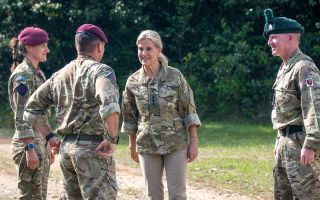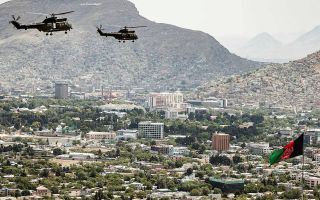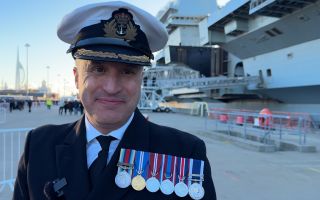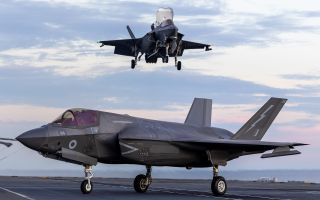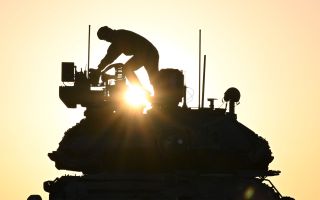Why US Marine Corps mascot is a British bulldog and how it built bond with Royal Marines
The British bulldog has been a powerful symbol of the UK since the Second World War after a cartoon was printed in the Daily Express combining an image of the dog with Prime Minister Winston Churchill's resolute face.
In a call for unity and strength in our fight against Nazi Germany, the words "Go to it – and keep at it" were printed below.
So how then did a breed of dog so intertwined with British culture become the mascot of the US Marine Corps and what role did the Royal Marines play in the history?
Oorah, Devil Dogs
There is a legend that, after the US joined the First World War in April 1917, German forces started referring to US Marines as teufel hunden which translates into devil dogs.
It is rumoured this nickname was given to them after the brutal Battle of Belleau Wood, a significant moment in the history of the US Marine Corps as it was its first large-scale engagement and left 1,811 dead and 7,966 wounded.
In a now archived 2011 stripes.com article, Bob Aquilina of the Marine Corps History Division says: "The term [Devil Dogs] very likely was first used by marines themselves and appeared in print before the Battle for Belleau Wood.
"It gained notoriety in the decades following World War I and has since become a part of Marine Corps tradition."
Meanwhile, America's entry into the First World War increased the need for recruitment which led to the creation of an attention-grabbing image using the term "teufel hunden", one that would cement the British bulldog, also known as an English bulldog, as being part of US Marine Corps' history.
Charles B Falls, an American artist known for his recruitment and motivational paintings during the First World War, created the poster which featured a red-eyed British bulldog (representing the US armed forces) chasing a Dachshund (representing Germany's armed forces).
Jiggs I
Legend has it that marines, having embraced their devilish new nickname, became rather fond of the British bulldog portrayed in the poster and so, in 1922, Private Jiggs – named after Mr Jiggs from the cartoon Maggie and Jiggs –became the first unofficial US Marine Corps mascot.
Originally named King Bulwark, Pte Jiggs was enlisted in the US Marine Corps for life on 14 October 1922 by Brigadier General Smedley D Butler.
During his short life, the much-loved mascot rose through the ranks at an impressive rate, becoming sergeant major in 1924, despite his cheeky behaviour getting him court-martialed occasionally.
He can be seen in the 1926 silent film Tell It To The Marines (the first film created in collaboration with the US Marine Corps) lying next to actor Lon Chaney who played Sergeant O'Hara.
The actor became the first film star chosen as an honourary Marine due to his accurate portrayal.
After Sgt Maj Jiggs died in 1927, many US Marines mourned his death, so he was laid in state in a hangar at Marine Corps Base Quantico, in a white satin-lined coffin.
Private Pagett
After hearing of Sgt Maj Jiggs' death, General Sir Alexander Hutchison, Adjutant General Royal Marines, decided to gift the grieving US Marine Corps a British bulldog, named Private Pagett by the Royal Marines.
He was alerted to this idea thanks to Allan Mowbray, a Brit living in Boston who was so moved by the corps' response to Sgt Maj Jiggs' death he wrote the following to Gen Sir Hutchison.
He said: "The extreme affection the US Marines had for this dog makes it impossible for it to be replaced in any ordinary manner, but the presentation of an English bulldog by the Royal Marines would, I feel sure, do much towards cementing the growing friendship between the two countries."
In response, Lieutenant General John Archer Lejeune – considered by many US Marines as "the greatest of all Leathernecks" – said: "It will indeed be a real pleasure for the United States Marines to receive their new mascot from the Royal Marines.
"Such a presentation would form an additional entry in the log of friendship that already exists between the two bodies of men.
"As Commandant of the American Marines, permit me to say that we consider your proposal a very friendly act and one showing truly fine spirit."
Brig Gen Willams goes on to say: "... he comes to them from another famous Corps of Marines, whose duties are similar, whose language is the same, and whose aspirations and esprit are marked by the same loyalty to flag and country and devotion to the service."
Pte Pagett did not become Jiggs II, instead that honour fell to a British bulldog named Silent White Richard, owned by former US Marine turned heavyweight boxing champion Gene Tunney who had also been moved by the death of the Marine's first mascot.
In 1957 a new tradition started – naming each new mascot Chesty after the late Lt Gen Lewis 'Chesty' Puller, one of the most decorated US Marines and the only one to win the Navy Cross five times for extraordinary heroism in the presence of great danger.
Wilfully disobeying
In September 1979, Private First Class Chesty VI was demoted after "ripping and tearing up an Everlast striking bag" caused $176.80 worth of damage to US military property.
For his crimes, he was reduced to the rank of private.
In the area of the charge sheet Chesty VI was expected to sign, it reads: "Marine refused to sign".
Just two years later Chesty VI's cheeky side struck again and he was written up for biting the feet of two corporals.
Instead of signing the piece of paper, Chesty VI left his paw print.
The mascots have their own service record books, dress uniforms, are treated equally to other marines and can even receive medals such as the Good Conduct Medal – as long as they don't bite anyone.
Also, thankfully, while marching with other marines, they don't have to keep in step.
Each British bulldog mascot symbolises the devil dog inside every US Marine Corps soldier.
While not standing the watch, they play a crucial role in boosting morale by performing in drill ceremonies and parades, making appearances at family days and sports events plus starring in lighthearted social media posts.
They also often outrank the marines they serve alongside.


